| diagram | 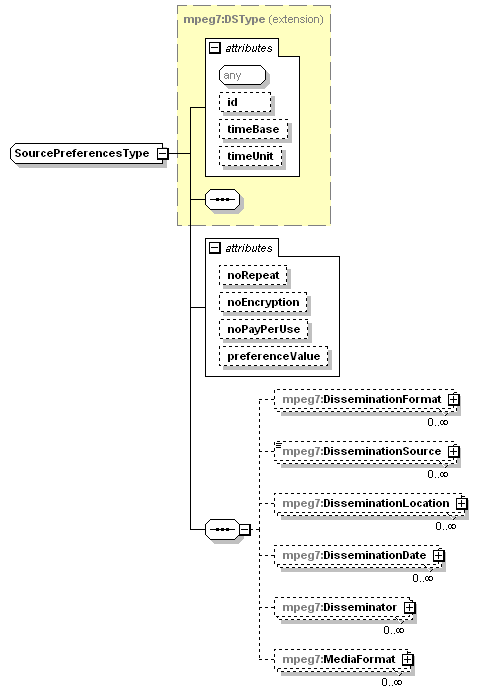 |
||||||||||||||||||||||||||||||||||||||||||||||||
| namespace | urn:tva:mpeg7:2005 | ||||||||||||||||||||||||||||||||||||||||||||||||
| type | extension of mpeg7:DSType | ||||||||||||||||||||||||||||||||||||||||||||||||
| properties |
|
||||||||||||||||||||||||||||||||||||||||||||||||
| children | mpeg7:DisseminationFormat mpeg7:DisseminationSource mpeg7:DisseminationLocation mpeg7:DisseminationDate mpeg7:Disseminator mpeg7:MediaFormat | ||||||||||||||||||||||||||||||||||||||||||||||||
| used by |
|
||||||||||||||||||||||||||||||||||||||||||||||||
| attributes |
|
attribute SourcePreferencesType/@noRepeat
| type | xs:boolean | ||
| properties |
|
attribute SourcePreferencesType/@noEncryption
| type | xs:boolean | ||
| properties |
|
attribute SourcePreferencesType/@noPayPerUse
| type | xs:boolean | ||
| properties |
|
attribute SourcePreferencesType/@preferenceValue
| type | mpeg7:preferenceValueType | |||||||||
| properties |
|
|||||||||
| facets |
|
element SourcePreferencesType/DisseminationFormat
| diagram |  |
||||||||||||||||||
| namespace | urn:tva:mpeg7:2005 | ||||||||||||||||||
| type | extension of mpeg7:TermUseType | ||||||||||||||||||
| properties |
|
||||||||||||||||||
| children | mpeg7:Name mpeg7:Definition | ||||||||||||||||||
| attributes |
|
attribute SourcePreferencesType/DisseminationFormat/@preferenceValue
| type | mpeg7:preferenceValueType | |||||||||
| properties |
|
|||||||||
| facets |
|
element SourcePreferencesType/DisseminationSource
| diagram | 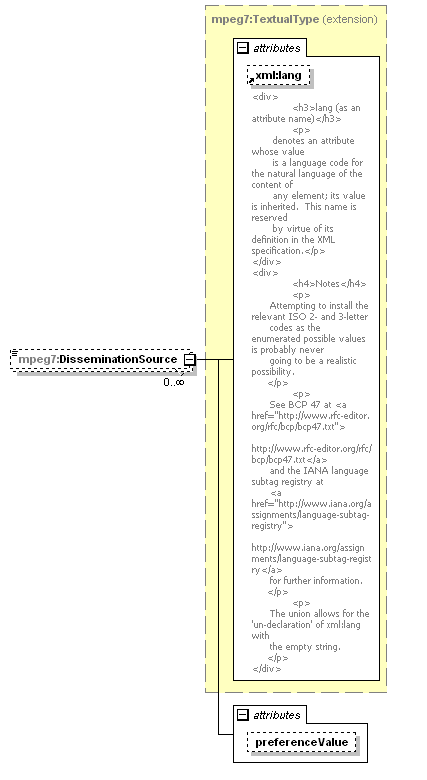 |
||||||||||||||||||||
| namespace | urn:tva:mpeg7:2005 | ||||||||||||||||||||
| type | extension of mpeg7:TextualType | ||||||||||||||||||||
| properties |
|
||||||||||||||||||||
| attributes |
|
attribute SourcePreferencesType/DisseminationSource/@preferenceValue
| type | mpeg7:preferenceValueType | |||||||||
| properties |
|
|||||||||
| facets |
|
element SourcePreferencesType/DisseminationLocation
| diagram | 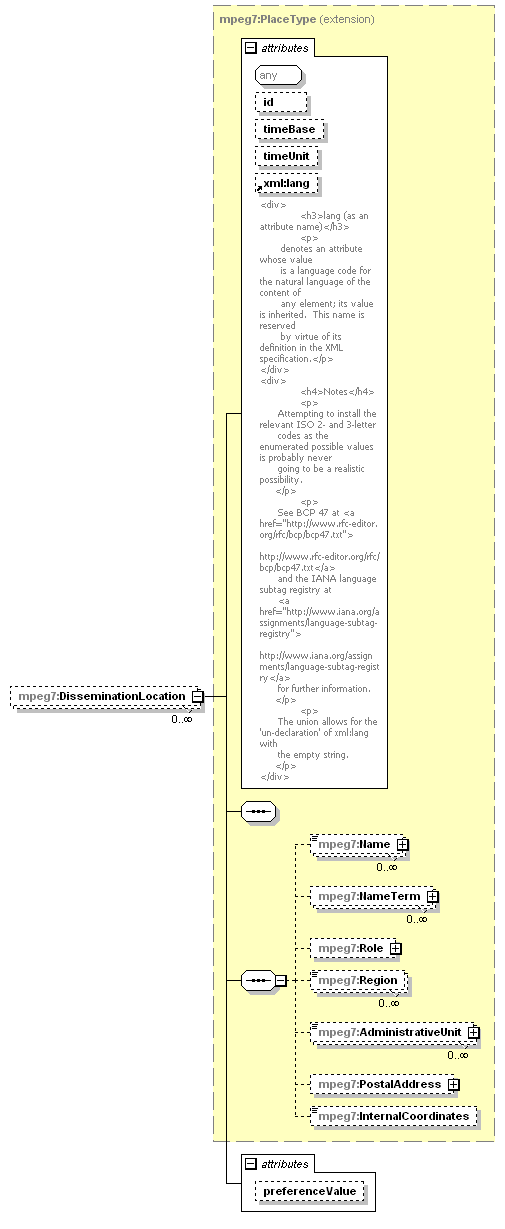 |
||||||||||||||||||||||||||||||||||||||
| namespace | urn:tva:mpeg7:2005 | ||||||||||||||||||||||||||||||||||||||
| type | extension of mpeg7:PlaceType | ||||||||||||||||||||||||||||||||||||||
| properties |
|
||||||||||||||||||||||||||||||||||||||
| children | mpeg7:Name mpeg7:NameTerm mpeg7:Role mpeg7:Region mpeg7:AdministrativeUnit mpeg7:PostalAddress mpeg7:InternalCoordinates | ||||||||||||||||||||||||||||||||||||||
| attributes |
|
attribute SourcePreferencesType/DisseminationLocation/@preferenceValue
| type | mpeg7:preferenceValueType | |||||||||
| properties |
|
|||||||||
| facets |
|
element SourcePreferencesType/DisseminationDate
| diagram |  |
||||||||||||
| namespace | urn:tva:mpeg7:2005 | ||||||||||||
| type | extension of mpeg7:TimeType | ||||||||||||
| properties |
|
||||||||||||
| children | mpeg7:TimePoint mpeg7:RelTimePoint mpeg7:RelIncrTimePoint mpeg7:Duration mpeg7:IncrDuration | ||||||||||||
| attributes |
|
attribute SourcePreferencesType/DisseminationDate/@preferenceValue
| type | mpeg7:preferenceValueType | |||||||||
| properties |
|
|||||||||
| facets |
|
element SourcePreferencesType/Disseminator
| diagram | 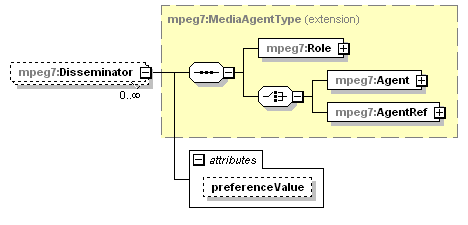 |
||||||||||||
| namespace | urn:tva:mpeg7:2005 | ||||||||||||
| type | extension of mpeg7:MediaAgentType | ||||||||||||
| properties |
|
||||||||||||
| children | mpeg7:Role mpeg7:Agent mpeg7:AgentRef | ||||||||||||
| attributes |
|
attribute SourcePreferencesType/Disseminator/@preferenceValue
| type | mpeg7:preferenceValueType | |||||||||
| properties |
|
|||||||||
| facets |
|
element SourcePreferencesType/MediaFormat
| diagram | 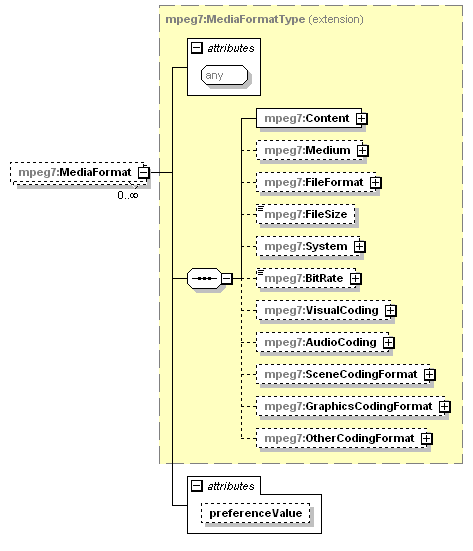 |
||||||||||||
| namespace | urn:tva:mpeg7:2005 | ||||||||||||
| type | extension of mpeg7:MediaFormatType | ||||||||||||
| properties |
|
||||||||||||
| children | mpeg7:Content mpeg7:Medium mpeg7:FileFormat mpeg7:FileSize mpeg7:System mpeg7:BitRate mpeg7:VisualCoding mpeg7:AudioCoding mpeg7:SceneCodingFormat mpeg7:GraphicsCodingFormat mpeg7:OtherCodingFormat | ||||||||||||
| attributes |
|
attribute SourcePreferencesType/MediaFormat/@preferenceValue
| type | mpeg7:preferenceValueType | |||||||||
| properties |
|
|||||||||
| facets |
|
XML Schema documentation generated by XMLSpy Schema Editor http://www.altova.com/xmlspy